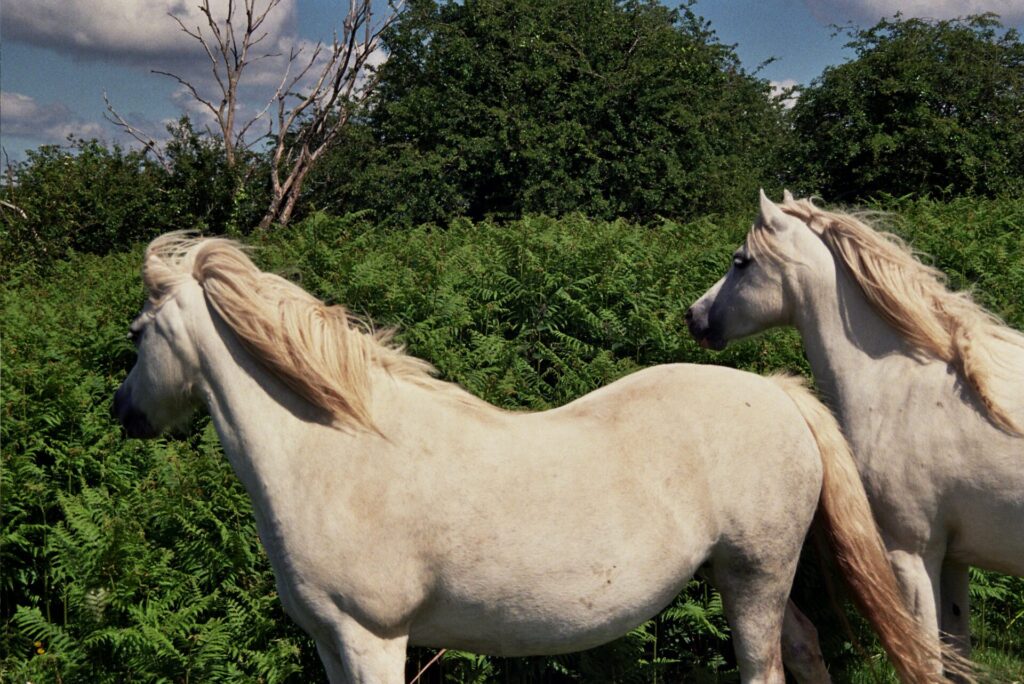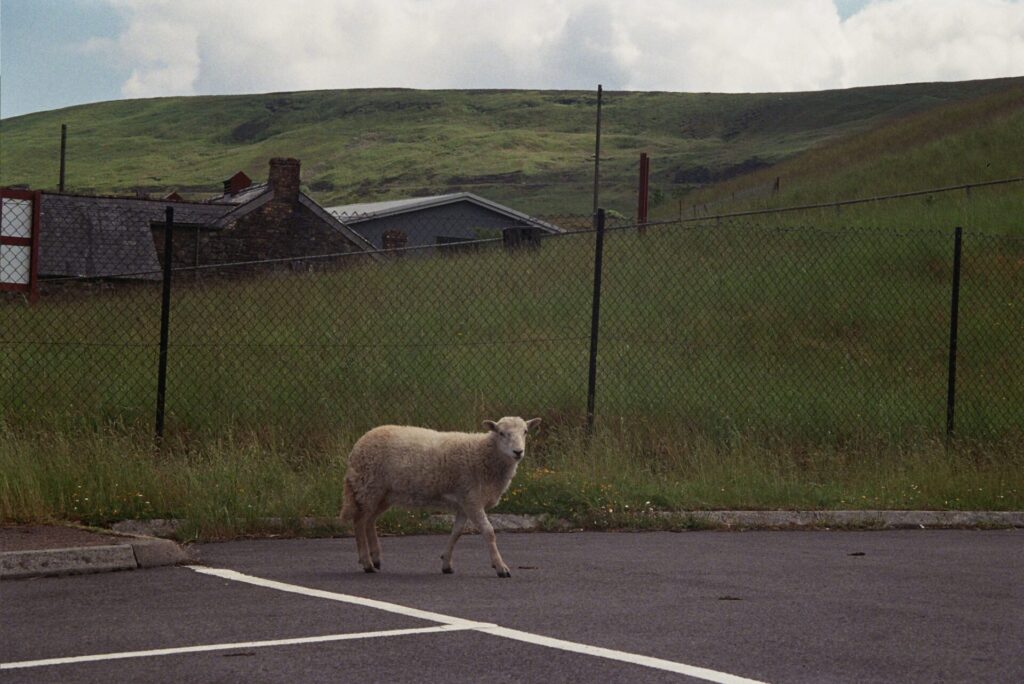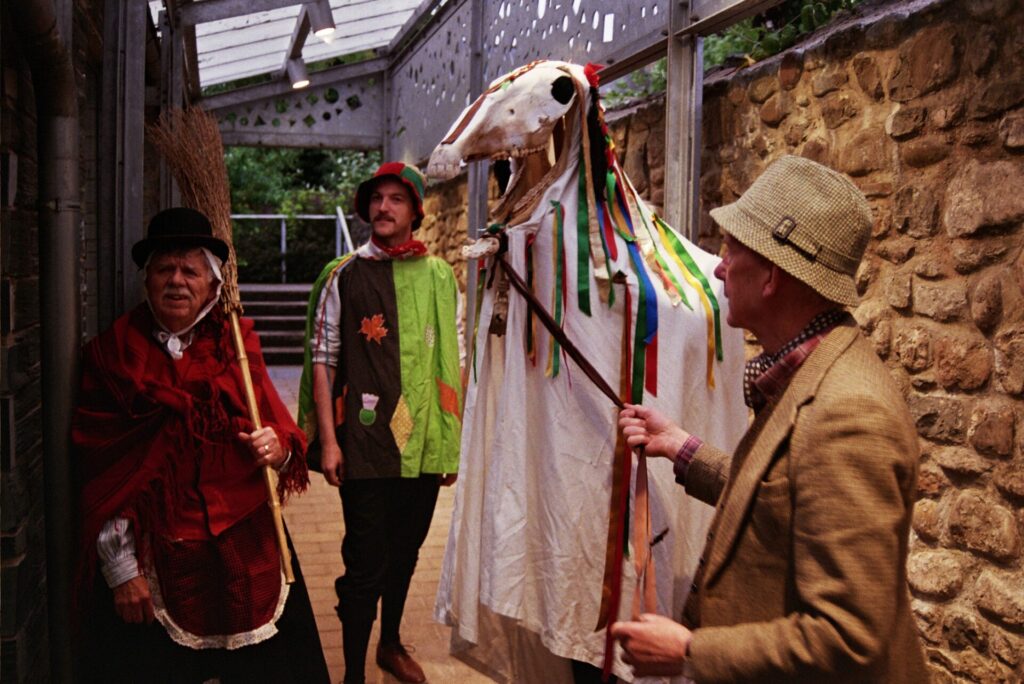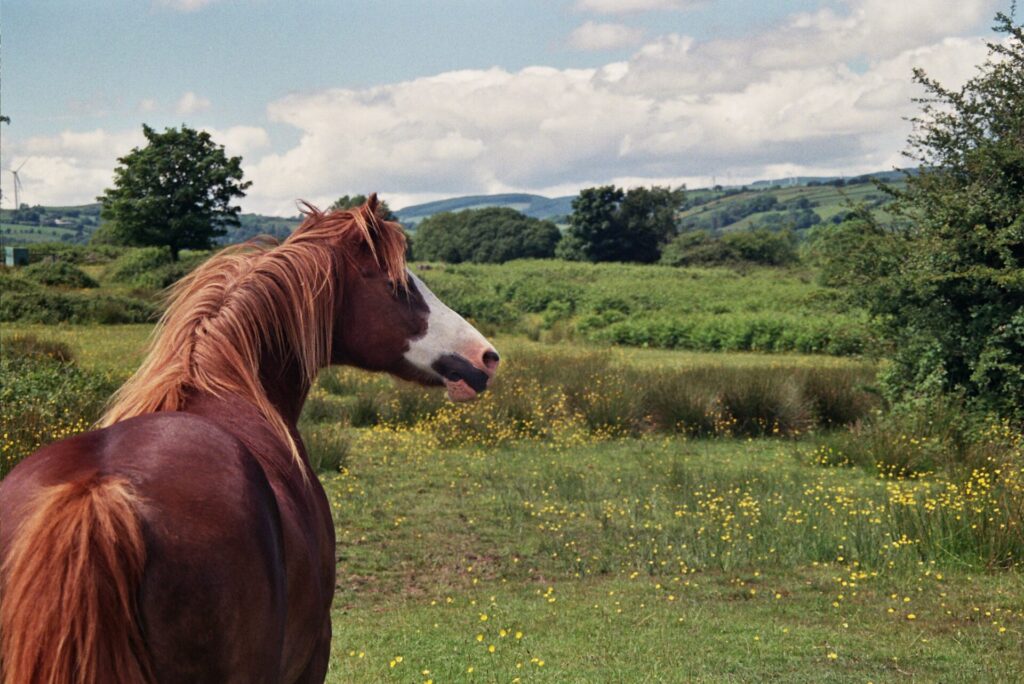Uncovering the many-layered history of South Wales, Hannah Pezzack’s essay explores the intersections of industry, ecological transformation, and mystical traditions that still endure. Journeying to the Brecon Beacons (Bannau Brycheiniog) – the mountainous national park – she encounters wild Welsh Mountain ponies alongside photographer Charlie Pezzack. These semi-feral herds descend from pit ponies, an ancient breed cultivated in recent centuries for coal mining work. This industry once dominated the region, its spectral presence lingering in disused machinery: colossal shafts, rusting winches, and long-burned-out chimneys. Now, Welsh Mountain pony numbers are in decline, a challenge that calls for ongoing conservation efforts.
Meanwhile, in the village of Llantrisant, horses graze on pastures that have been communal since before the enclosures – a time from the 1600s to the 1800s, when shared land – former social and cultural centrepoints, used for food production and livestock – was privatised, placed in the hands of affluent landowners, impoverishing communities and irreparably transforming rural existence. Today, the land ownership disparity, cemented during the enclosures, continues to have dire consequences, hindering wildlife protection endeavours and entrenching wealth inequality.
Documenting the ritualistic Welsh practice of the Mari Lwyd, Pezzack delves into the ties between land and labour, human and animal lives, examining how our pasts, presents, and uncertain futures are bound together.

Tir cyffredin (Common ground)
As far as the eye can see, endless, flat grassland stretches onwards. Far away, where the moor touches the sky, hunched mountains rise, dark against the horizon. The flat-topped summit of Pen y Fan, the third tallest peak in the United Kingdom, is visible, flanked by its siblings, the only slightly shorter Corn Du and Cribyn.
The ponies have a long association with Wales. Short and sturdy, they are well suited to life among the rocks and crags. Characterised by their even temperament and toughness, these creatures have lasted for millennia – yet their fate now hangs in the balance.
Unlike in countries such as Germany and America, national parks in the UK are largely privately owned, with much of the land controlled by wealthy individuals and corporations rather than the public. In his book, The Lie of the Land (2024), campaigner and investigator Guy Shrubsole reveals that just 1% of the population controls over half of England. Archaic laws, established in the eighteenth century, grant landowners near-absolute control, which hinders the ability of national park authorities to meet conservation targets. A striking example is the widespread burning of peat for grouse and pheasant shooting, a sport favoured by aristocrats. Peatlands are one of the UK’s most effective carbon stores, but when set alight, they release vast amounts of carbon dioxide into the atmosphere. This practice also depletes biodiversity and accelerates ecosystem degradation, yet landowners face little accountability.
While the Brecon Beacons is by far the most communal of all the national parks, its public land accounts for a minute fraction – only about 13%. Without the economic incentive of breeding horses for mine work, the limited access to suitable grazing areas – much of it privately owned and used for commercial agriculture or game shooting – hinders attempts to effectively steward the Welsh Mountain ponies.
Calling for a dissolution of estates and reformation of land ownership, Shrubsole draws on the subversive demands found in Mediaeval folk poetry, such as the 1611 verse Powte’s Complaint, which protests the destruction of the Fens – shared wetlands vital to peasants. Such a gesture mobilises what cultural analyst Esther Peeren and her co-authors of Planetary Hinterlands (2024) call a ‘biophilia that refuses to indulge in nostalgia but instead seeks to re-operationalise past anti-capitalist rebellions in the present.’ Rather than merely reconstructing what has come before, we might exceed the limits of reminiscence for ‘lost’ landscapes and radically re-make the world anew.

Llantrisant Common
Back in Charlie’s dusty car – a second-hand gift from our grandparents long ago, that has somehow survived against the odds – we drive towards Llantrisant. The village common is among the oldest community-owned land in the United Kingdom, where local horses can wander freely. The birthplace of William Price, a neo-Druid and radical Socialist organiser, Llantrisant is home to many pagan traditions. One such example is the Mari Lwyd, where a horse skull, covered in a white sheet and adorned with ribbons and bells, is paraded through the streets to the sound of a call-and-response song. The origins of Mari’s name are mysterious. One translation, ‘Grey Mare’, links her to the pale horses of Celtic mythology, many of whom can cross into the underworld. In Welsh mythos, the animals have long been associated with the ghostly and spectral, moving between the realm of the living and the dead.
When Charlie and I arrive in Llantrisant, the Beating of the Bounds festival is underway – a seven-mile trek that traces the boundary of the ancient borough. This activity, which originated in medieval times, reaffirms the parish, with the community walking the perimeter and symbolically ‘marking’ it with rituals. Strolling onto the sunny common – a stretch of tussocked fields dotted with brambles – we encounter a group of snow-white ponies who greet us eagerly, nudging our hands with their warm noses. As we stroke their sleek flanks, an auburn, white-socked mare circles us, skittish and playful. In the distance, we can see a long train of figures – several hundred people – trailing along the village’s periphery.
After bidding farewell to the animals, we set off in search of the Mari Lwyd puppet, which, according to local accounts, is likely to be found hanging out in one of the pubs. However, she proves elusive amidst the ongoing fête. When I ask a man on the church steps if he’s seen her, he tells me she passed by earlier but is probably back in storage by now. His face lights up when I ask about the wassailing. ‘It’s so much fun’, he laughs. ‘She’ll leer down at you – this great big skeleton! It’s terrifying and hilarious, especially after a few drinks.’ I then inquire about the common: who does it belong to? Who can go there? ‘It belongs to the community – everyone is welcome here. It’s been that way for as long as anyone can remember – a thousand years or more,’ he says. ‘However, the right to graze livestock is reserved for the Freemen of Llantrisant – a local historic group with inherited rights. A while back, for example, a bunch of gypsies came and let about 50 horses loose. They were in pretty bad shape – not looked after properly at all. We told them to move on.’
This comment lingers with me – a reminder that, despite this stranger’s friendliness to Charlie and me, others are not so welcome. Roma and traveller communities are among the most discriminated against groups in the UK. They face prejudice in many forms, from difficulty accessing education and healthcare to frequent eviction. Moreover, as researchers Emma Renold and Gabrielle Ivinson write in their 2014 paper Horse-Girl Assemblages, ‘Sensationalist media stories of horse neglect and abuse emerge from time to time across the Anglophone world, and Wales is no exception. ’Rarely, however, do media headlines connect human and animal cruelty (hum/animal) to […] exploitation and poverty.’ Such narratives vilify individuals, portraying them as inherently vindictive, while overlooking the systemic inequalities that often contribute to instances of mistreatment.
As we passed through the Rhondda – part of The Valleys, once the epicentre of coal production – banners for the Reform Party, Britain’s far-right group with its vehemently anti-migrant stance, were impossible to miss. Increasingly, there is a desire here to shut out outsiders, to police who belongs – a sentiment I cannot ignore. If this land is truly to be for everyone – if it is to bring about an inclusive, collective horizon – then it must also be liberated from a narrow conception of Welshness. As Silvia Federici reminds us in her book Re-enchanting the World (2018), the commons are not inherently subversive, but they become so when they challenge the hierarchies, power structures, and divisions on which capitalist relations rely – when they become sites of struggle that invert the order of things.

Mari Lwyd
Not wanting to miss a firsthand encounter with the Mari Lwyd, I begin an email correspondence with Dai James of Cwmni Dawns Werin Caerdydd, who meet weekly to practise Welsh folk dancing. Dai enthusiastically invites us to visit him and the troupe at a community hall near Llandaff Cathedral. ‘Our Mari Lwyd happens to be the oldest “revived” one in Wales, so we would be honoured to talk to you’, he writes.
On a rainy Thursday evening in late May, Charlie and I find ourselves waiting in a car park. Dai comes out to meet us, welcoming me in Welsh, English, and Dutch – a language he picked up during cultural exchanges with the Netherlands. Inside, the hall is bustling with activity. We are introduced to people of all ages, some younger, and many who have been involved in this heritage practice for decades.
‘Strictly speaking, this should only be performed during the Christmas season’, we are told. ‘But we’re making an exception.’ We say our thanks and find a spot in the corner, so as not to obstruct the Mari’s pathway. The puppet is far larger than I imagined – held by a tall man, its hollow eyes gaze sightlessly high above me. Outside the doorway, the procession begins – first, a group of men leads the song, their voices rising in rhythm, filling the air with an eerie chant:
Wel dyma ni’n dwad
Gyfeillion diniwad
I ofyn am gennod i ganu
(‘Here we come
Dear friends
To ask permissions to sing’)
They knock on the door, asking to be let in. On the other side, the women respond, refusing the Mari entry. She snaps her jaws in frustration – the cracking bones echoing off the concrete walls – and shakes her head, sending her bells ringing. This is the poetic, choral battle known as pwnco – some verses are always included, while others are invented on the spot, and involve personalised jokes and taunts. If the Mari team wins, they are invited inside, where they are treated to cake, ale, or money.
Taking place during the darkest part of the year, the ritual signals the end of the old and the arrival of new life, aligning with seasonal cycles. The door-to-door contest of wit is regarded as a form of social bonding, bringing neighbours together in defiance of winter’s harshness. As is the case with the Cwmni Dawns Werin Caerdydd, the puppet is sometimes accompanied by an ostler, sergeant, and Pwnsh a Siwan (Punch and Judy) characters – popular pantomime figures added during the Victorian era – reflecting how the tradition blended and adapted with the times.
The Mari Lwyd was first written about in the early nineteenth century by English schoolmaster and topographer, John Evans. Though this is the earliest testament, it is believed to be much older, likely rooted in pre-Christian Celtic customs that sanctified animals, regarding them as symbols of fertility, protection, and renewal. Evans’ account coincided with a period of cultural change, when the Welsh folk practice was suppressed – primarily by the Church and conservative Victorian reformers, who viewed it as unruly and immoral – speaking to the disruptive power it once held. Unproductive, festive customs such as drunken wassailing (although largely co-opted into the Christian order) conveyed a more instinctual, desire-led form of communal expression. As Federici states in Witches, Witch-Hunting, and Women (2018), ‘It is a way of being that ‘we now call superstitious, but at the same time, alerts us to the existence of other possibilities of being in relationship to the world’ – one where the boundaries between humans and animals, life and death, become porous.
Over a beer at the pub, Dai graciously answers my many questions. ‘You know’, he says, ‘it’s likely that some of the skeletons would have come from pit ponies or work horses’. I think about how this is possibly yet another link between industry and ecology – how the bones might carry forward the memory of their once-vital labour, preserving the spirit of these animals whose exploited bodies re-shaped the landscape.
Alongside Charlie’s photographs, I tried to record the performance on my Tascam, but I was so mesmerised that I forgot to adjust the levels, resulting in dramatic clipping. When I listen back, it is distorted and warbling – the sound of an ephemeral encounter; an in-between, half codified and half distorted beyond recognition.
The research for this essay was conducted with the generous assistance of Ruben Verkuylen, Jackie Neale, and Alison Carpenter. Many thanks to them for their invaluable help with photographing, transport, and navigation. Ecoes #7 can be ordered from the Sonic Acts web shop.


